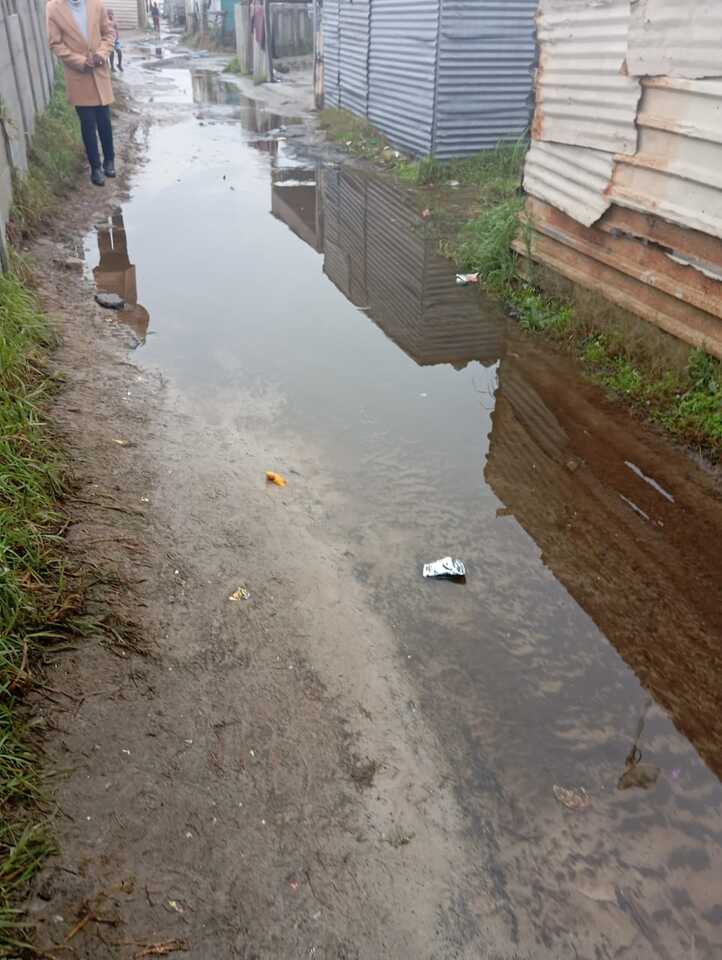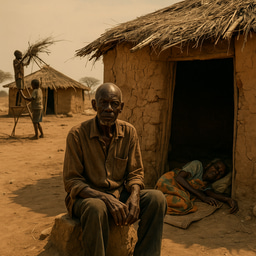Adapting from Below: Flooding, Informality, and the Power of Community Resilience
Published in Social Sciences, Earth & Environment, and Sustainability

The Story Behind the Research
The seeds of this research were planted during my fieldwork in Cape Town's informal settlements, where I walked through flooded footpaths, listened to residents’ survival stories, and observed grassroots ingenuity in real time. I remember standing ankle-deep in water in Khayelitsha after a storm, watching a group of women redirect stormwater with makeshift tools: stones, sticks, and plastic sheets. What struck me wasn’t just the devastation but the dignified defiance: “We can’t wait for the city; we adapt or drown.”
That moment stayed with me. It raised deep questions: What forms of adaptation are emerging from below? How do vulnerable communities cope, respond, and rebuild, often without external help? And what can the world learn from these frontline actors?
Listening to Voices from the Margins
My study looked at 15 case studies across Asia, Africa, and the Pacific, with countries like South Africa, Kenya, Bangladesh, Indonesia, and Fiji providing insights into diverse flood-prone informal settlements. These settlements are often located on floodplains, wetlands, or unstable slopes: places deemed unworthy of investment.
And yet, they pulse with agency. Whether through community-led reblocking in Cape Town, bamboo stilt housing in Jakarta, or digital storytelling in Kibera, residents are not waiting for saviours. They are designing their own adaptive futures.
Theoretical Lenses and Conceptual Innovations
At the heart of this study is the concept of Community-Based Adaptation (CBA) - a bottom-up approach that empowers communities to identify, prioritise, and implement flood responses tailored to their needs. But CBA is more than just participation. It is a political act, a reclaiming of power and space in cities that too often marginalise the poor.
I also engage with ideas of:
- Participatory resilience: Resilience shaped with, not for, communities.
- Environmental justice: Recognising that flooding isn’t just natural, it's also political.
- Localism and place-based knowledge: Treating community members as experts of their own environments, not passive victims.
- Urban political ecology: Viewing flooding as a product of socio-political processes, not just climate.
Challenges in the Field
Studying adaptation in informal settlements is emotionally demanding. You witness the violence of neglect, children playing beside overflowing drains, elders losing belongings year after year. But there's also ethical complexity. How do you document suffering without sensationalising it? How do you honour local knowledge while still critiquing systemic failures?
The research also revealed governance gaps. In many cases, promising community initiatives were stifled by bureaucratic inertia, legal exclusion, or a lack of sustained funding. It’s difficult to build resilience on a foundation of precarity.
Key Findings
The study found that communities are adapting in three broad ways:
- Physical and infrastructural solutions: Like raising houses on stilts, creating local drainage channels, or community-led reblocking.
- Social and cultural practices: Savings groups, youth storytelling platforms, and indigenous knowledge (e.g., traditional flood prediction methods).
- Digital and institutional innovations: Early warning systems via mobile phones, community radio, and participatory mapping tools.
However, the success of these measures depends on key enablers: trust, social cohesion, institutional support, and resource access.
Why It Matters
This research challenges the myth that poor communities are helpless in the face of climate disasters. Instead, it reframes them as leaders in innovation and resilience. But their efforts often remain fragmented and under-resourced. Unless their strategies are integrated into city-wide planning and supported with adequate funding, the burden of adaptation will continue to fall unfairly on those least responsible for the climate crisis.
In an era of growing climate risks, the sustainability of cities hinges not only on green infrastructure but also on inclusive governance, where the knowledge, voices, and capacities of the urban poor are recognised as essential.
Reflections and Hopes
What I hope readers take away is this: adaptation is not just about sandbags and storm drains. It’s about power, equity, and belonging. Floods expose more than infrastructure gaps; they expose deep social fractures—who counts, whose homes are protected, whose lives are rebuilt.
We need to centre justice in climate adaptation. Not as an afterthought, but as the starting point.
A Note to Fellow Researchers
To those working in similar contexts: your work matters. But tread carefully. Do not just extract stories, build relationships. Stay longer. Return if you can. Pay attention to silences. Let your writing carry the dignity of those who trusted you with their lives.
Also, share your findings with communities, not just about them. Research should not stop at publication; it must ripple back to where it began.
Call to Action
- For planners: Design with, not for, communities.
- For policymakers: Recognise informal settlements as part of the city, not its margin.
- For donors: Fund grassroots-led projects with long-term commitments.
- For the public: Don’t dismiss “slums” as chaotic or hopeless. They are vibrant, self-organising, and full of lessons on how to live with crisis.
Floods will continue to come. But resilience is already there hidden in alleyways, encoded in community networks, whispered in songs and stories of survival. Our task is to recognise it, nurture it, and stand in solidarity with those already adapting from below.
Follow the Topic
-
Discover Sustainability

A multi-disciplinary, open access, community-focussed journal publishing results from across all fields relevant to sustainability research whilst supporting policy developments that address all 17 of the United Nations Sustainable Development Goals (SDGs).
What are SDG Topics?
An introduction to Sustainable Development Goals (SDGs) Topics and their role in highlighting sustainable development research.
Continue reading announcementRelated Collections
With Collections, you can get published faster and increase your visibility.
Advancing Sustainable Development: The Role of Circular Economy Practices, Green Innovation and Corporate Responsibility
Achieving sustainable development, as envisioned in the United Nations’ 2030 Agenda, requires transformative solutions to reconcile economic growth with environmental and social imperatives. Circular economy practices, green innovations, and corporate responsibility stand out as critical drivers in this effort—reducing resource depletion, fostering innovation, and embedding accountability into global systems. Yet, their combined potential to accelerate progress toward the Sustainable Development Goals (SDGs) remains underexplored. This Collection aims to unravel these synergies, offering actionable insights for researchers, policymakers, and practitioners committed to a sustainable future.
Keywords: Sustainable Development, Circular Economy Practices, Green Innovation, Corporate Responsibility, Challenges and Opportunities in Sustainable Development.
This Collection supports and amplifies research related to SDG 7, SDG 12, SDG 13 and SDG 17.
Publishing Model: Open Access
Deadline: Apr 01, 2026
Transforming Education for Innovation, Sustainability, and Social Responsibility
Education plays a key role in addressing today’s global challenges, including climate change, social inequalities, and technological changes. As the world becomes more complex, education must transform to prepare students for the future. This Collection will explore how education can support innovation, sustainability, and social responsibility. By focusing on new teaching methods, policies, and institutional changes, this issue aims to contribute to meaningful educational reforms. Research in this area will help create a learning environment that fosters problem-solving, critical thinking, and ethical decision-making among students.
Technological advancements such as artificial intelligence, automation, and digital transformation are changing how people work and learn. To keep up with these changes, education must teach the skills needed for the future (SDG 9). Climate change is another major challenge that requires education systems to focus on sustainability and environmental awareness (SDG 13). Social and economic inequalities make it difficult for many people to access quality education and opportunities for success (SDG 10). Education must become more inclusive and fairer, ensuring equal opportunities for all (SDG 4). Additionally, global challenges like migration, cultural diversity, and human rights require an education system that promotes ethical responsibility and global citizenship (SDG 16). Many education systems are outdated, face funding issues, and struggle to adapt to modern needs, highlighting the need for research that guides policy improvements (SDG 4).
This Collection supports several United Nations Sustainable Development Goals (SDGs), including SDG 4 (Quality Education), SDG 9 (Industry, Innovation, and Infrastructure), SDG 10 (Reduced Inequalities), SDG 13 (Climate Action), and SDG 16 (Peace, Justice, and Strong Institutions). Education for sustainability fosters environmental awareness and responsible actions (SDG 13). Innovation in education drives technological and economic growth (SDG 9). Ensuring access to quality education promotes social equity (SDG 10). Encouraging social responsibility in education helps create a more just and ethical society (SDG 16).
We invite researchers to submit original papers for this Collection, welcoming various research approaches, including conceptual, empirical, and analytical studies. The scope of this Collection includes topics related to education, sustainability, and social responsibility. Suggested areas of interest include but are not limited to the following:
• Innovative Teaching Methods for the 21st Century
• Technology and Digital Transformation in Education
• Policy and Governance for Educational Reform
• Climate Change and Sustainability Education
• Equity and Inclusion in Education
• Ethics and Social Responsibility in Education
• Global Citizenship and Cross-Cultural Education
• Education for Employability and Skill Development
• Artificial Intelligence and Education
• Green Campuses and Sustainable Learning Environments
• Training for Sustainability and Innovation
• Community Engagement and Public Awareness through Education
• Promoting Green HRM, Marketing, Leadership, & Entrepreneurship in Education
The target audience for this Collection includes researchers, policymakers, educators, and professionals involved in educational reform, sustainability, social sciences, and technology. Contributions from different regions and contexts are encouraged to provide a global perspective on these issues. By fostering research on innovation, sustainability, and social responsibility in education, this Collection aims to contribute to global efforts in transforming education. We look forward to high-quality submissions that help shape the future of education.
This Collection supports and amplifies research related to SDG
Keywords: Educational Innovation; Sustainability Education; Social Responsibility; Digital Transformation; Global Citizenship; Policy Reform in Education; Inclusive Education; AI in Education; Climate Action; SDGs and Education
Publishing Model: Open Access
Deadline: Jan 31, 2026





Please sign in or register for FREE
If you are a registered user on Research Communities by Springer Nature, please sign in